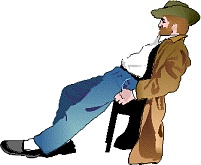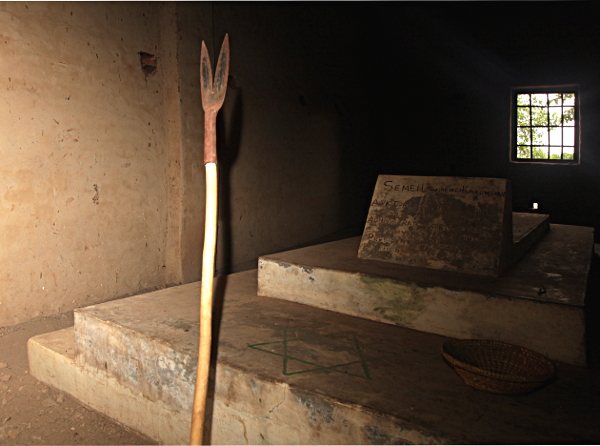| Menachem's Writings | 
|
A Travelogue: Visiting the "New" Jews of Africa
5. Visiting Kakungulu's House and Grave in Gangama,
and the Abayudaya of Nabugoye and Namanyonyi
This is part 5 of my East Africa Travelogue. The travelogue is divided into the following sections:
Pilgrimage to Gangama, home of Abayudaya Founder, Semei Kakungulu
After our elating visit to Putti, we return to our car, and head back down the dirt road to the main highway. We retrace our route, turning right back towards Mbale. A couple of miles on, we make a left turn onto another dirt road. The road begins to rise and narrow. It is full of ruts and troughs. It becomes quite steep and the condition worsens as we rise. Progress is slow. I am surprised our driver, Boniface, doesn't comment on driving on this road. He just keeps moving, very slowly up the mountain, trying his best to navigate around and between the deepest holes.
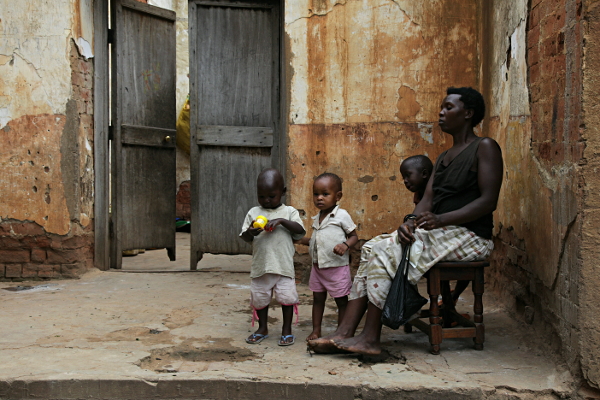 | |
|
Kakungulu's House, Gangama
|
We eventually reach a clearing, a relatively flat area, the land surrounding the ruins of Semei Kakungulu's spacious home. We are at the highest point on the hillock, Mount Elgon rising steeply in the background. A few lambs graze around the entrance to the house. A man is lying on the ground on a slight slope to the left of the building. He doesn't move the whole time we are here -- perhaps half an hour. I assume he is the caretaker and hopefully he is just sleeping.
A not happy looking lady is sitting on the porch of the ruins, five children of various ages around her. She may be the caretaker's wife. Enosh speaks to her but it is not clear to me what she has told him. She wears nothing on her feet and her garb implies intense poverty. Her children are either barefoot or wear thongs that are too big for them. Their clothes are neat, but far from new.
The house is built of mud bricks and cement rendered. Large swabs of cement have fallen off the outside walls, and most of the roof has fallen into the building. There are weather-worn shutters on the windows. All of them are closed, so I couldn't tell if they ever contained glass. The house is large but not palatial.
According to local custom, a person is buried near to his residence. Kakungulu's grave is housed in a building slightly below the house, off to the right. Indicating his warrior status, a spear stands in front of the grave. A blue magen david is painted at the foot of the grave, completing the picture of the man buried here.
|
The inscription on the grave reads
|
When we return to the house we are greeted by an unexpected visitor. A lady, in the traditional garb of the region, has arrived. Unlike the first lady at the house, the guest is clean and well dressed. She wears a gold chain around her neck, and has a very erect posture. She is obviously of good grooming. Enosh tells us that this lady is a granddaughter of Kakungulu, but she does not consider herself Jewish. I don't know from where she has appeared as there are no houses visible in the immediate area.
These sponsored links arrive via 3rd party feeds. We have no control over their content.
If they interest you, please feel free to click and see -- your interest in these advertisements covers our site expenses.
Visit to Nabugoye
Back in the car again and we head along a ridge towards the village on Nabugoye Hill. The road, although also unpaved, is in far better condition than our route up to Gangama. Most of the Abayudaya villages are located along this stretch of road. Magada is one of the Abayudaya villages not situated in this area. It is some seventy kilometres away. The people in Magada, though part of the "Jewish" people, originate from a different tribe to the remainder of the Abayudaya. There is a synagogue Magada. We did not visit there.
 | |
|
Inside the Nabugoye Synagogue
|
About two hundred "Jews" live in Nabugoye. It is not clear to me whether there are non-Jews living in the village as well. The area is open and people pass through, generally on foot, on the dirt track which doubles as the "main road".
From what I understand, a U.S. based organisation called Kulanu, "all of us", were the first outsiders to make serious contact with the Abayudaya tribe. According to their website, Kulanu works "to help dispersed remnants of the Jewish people". They work via "a network of people with a variety of backgrounds and religious practices". For reasons not completely clear to me, the Abayudaya were connected with the Conservative movement via Kulanu. This connection led to the sending of a member of the tribe to the U.S. to be trained as a rabbi and a group of Conservative "rabbis" travelling to Uganda to perform religious conversions.
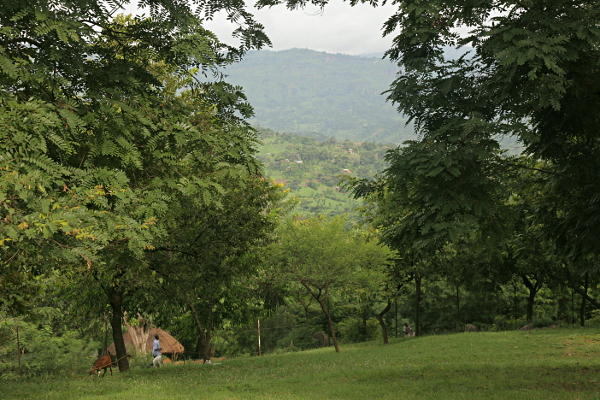 | |
|
Wanale Hill from Nabugoye
|
Gershom Sizomu,the U.S. trained Conservative rabbi, lives here in Nabugoye. He is a charismatic leader who has succeeded in bringing his people many services that are not readily available to the local surrounding population. Here there is a primary and high school, a medical clinic and surprisingly, a guest house with all the "modern" features, including running water, flush toilets, electricity and windows, that a westerner would expect in his lodgings.
Gershom shares his facilities with his non-Jewish neighbours. At the school, Jewish subjects are optional for the non-Jews. Gershom stood as a candidate in the recent national elections. He did not win his rural seat, but came within a thousand votes of the ruling party's incumbent. Vote rigging has been implied, but he is not challenging the result. We saw some of Gershom's election posters, still stuck to walls and doors, as we moved around the region. He appears in all of these proudly wearing his big smile and a big crocheted kippa. Because of his contribution to the general community, he is well respected by the majority Christian and Moslem populace, enjoying good relationships with all his neighbours.
The first place that Gershom shows us in Nabugoye is the synagogue. Prayer meetings take place here on Monday and Thursday mornings and on Shabbath. He tells us that two hundred people, men and women, attend every Shabbath. He shows us around other aspects of the village. Rabbi Riskin wants to meet with Gershom privately. That's my signal to take Eden for a walk around the village. I anyway was keen to take photographs here. The sun was commencing its descent towards its nightly resting place, providing me the warmest light of the day. I knew I had to move quickly to capture village life on film.
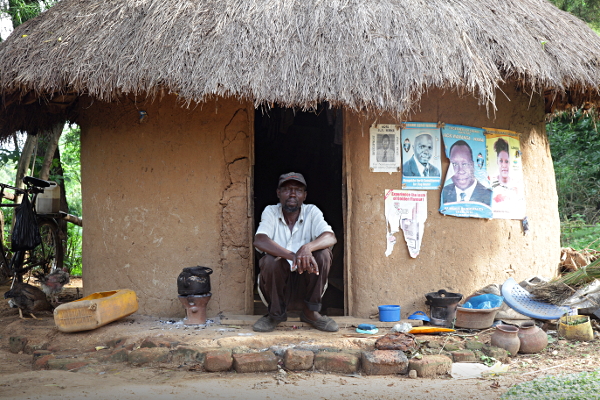 | |
|
Man Outside his House in Nabugoye Note Gershom's election poster, 2nd from the left |
Our walk was very rewarding. We spoke, largely in sign language, to a number of people and observed their way of life. Housing here is similar to that in Putti, though there is more empty space surrounding each dwelling. Most of the houses appear to be built of wattle and daub, sometimes with a mud brick annex. Farm animals, sheep and cows, are visible, something we did not see in Putti. While the residences don't appear to be connected to electric power nor possess window panes, the public buildings here, the shule, the high school and the medical clinic, are. The Shalom Shopping Centre even has a satellite dish and Internet connection. I'm not sure what they sell in this shop as they were already closed for the day. I suspect there must be a local generator in the village which provides whatever power there is.
After an hour meandering around the village, Eden and I return to where we had left the rabbi. The day was ending and Enosh still wanted us to visit the grave of Samsom Mugome, the second great Abayudaya leader, in nearby Namanyonyi. Boniface will soon start getting nervous about driving at night on the pot-holed highway. Overall he seems to be enjoying the visit. It appears to be as educational an experience for him as it is for us.
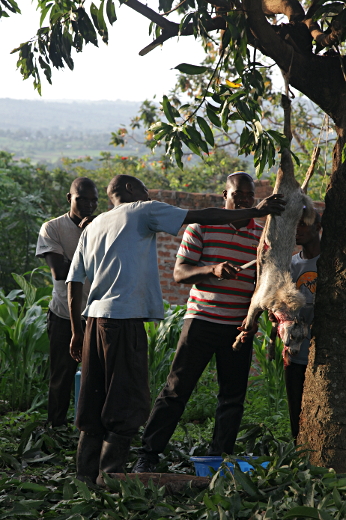 | |
|
Butchering Ari's Slaughtered shechted Goat
|
Ari again offers his services as a shohet. The tribe here, or so they tell us, does perform Jewish slaughter. Ari Greenspan suggests they bring out their sh'hita knife for the rabbi to inspect. Shochatim presenting their knives to a visiting sage, is a venerable Jewish custom. The locals bring out a huge knife, almost a machete, full of nicks along its length, each notch posing an additional halachic problem. Ari suggests that they reserve this knife for after slaughter butchering as he could see no way of turning this into a "kosher" knife. Our rabbi concurs.
Ari sharpens his knife on a stone as a goat is brought to the clearing Ari selects for the procedure. He is ready to start when a man suddenly approaches from outside the gathered circle, ties a rope around the goat's neck and drags it off the stage. I'm wondering what just happened. Perhaps the people weren't that hungry after all. No, it seems this was the goat's owner and on second thoughts, he didn't think the goat was ready to meet its Maker. Or perhaps no-one had bothered asking his permission to borrow his animal.
Soon a replacement goat arrives. Ari explains everything he does as he works, including how to check the kosher status of an animal post-mortem. He pulls out the lungs, explaining the various lobes and potential halachic pitfalls. This was a valuable lesson for them.
There is one "white" person in the village. He has now been here for a few months, assisting and learning from "Rabbi Gershom". He told me he is staying at the guest house where he is eating "western" food. He'll shortly be returning to the States. He graduated from university last year, but hasn't yet decided what he'll be doing next. After his experience here, he tells me he may go on to study to be a conservative rabbi.
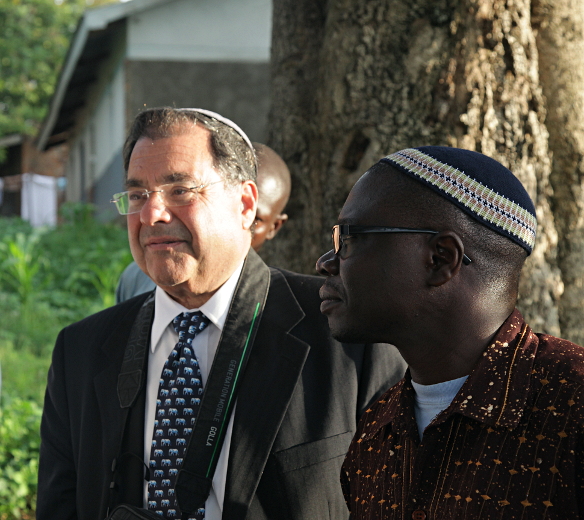 | |
|
Rabbi Riskin and "Rabbi" Gershom
|
It also appears that Gershom is running his own outreach program here, to other African countries. My new friend tells me that groups interested in Judaism have visited from Ghana and other neighbouring countries. It wasn't clear from the conversation whether Gershom was performing conversions himself.
I again saw and learnt a lot on this visit. However I noticed that I felt much more an observer here than in Putti where I had reached a real spiritual high. I wondered why this was.
The people I met here in Nabugoye were nice enough, certainly, on a one-on-one basis as nice as the people in Putti. Perhaps I was spiritually burnt out after Putti -- after all how high can one fly -- and from there the follow-up visit to the home and grave of the Abayudaya founder, Semei Kakungulu, effected me.
I think the fact that we met the Putti people in the shule doing "something" Jewish, in prayer, and that we met the people in Putti as a whole group, may have been the main factor. Here we met Gershom who showed us an empty synagogue, leaving filling the room to my imagination stimulated by his description of the shabbath crowds. All the people I spoke to here, and I spoke to quite a few, were individuals -- I did not feel the glue. And I suspect the fact that they were officially "Conservative Jews" had an adverse effect on my traditional upbringing and background. Rabbi Riskin once described me as a reactionary. I wear that badge with pride.
 | |
|
The Nabugoye Guest House
|
We return to the car, continuing along the road on which we had arrived. The sun starts its final descent and the photographer in me wonders whether I have finished my work for the day. The rabbi reports some aspects on his meeting with Gershom. He offered for him to come to Israel for a few months on a study tour, to become acquainted with Torah Judaism. He tried to explain that with all the good he has done for his people, and with all his good intentions, he was putting them in a difficult position vis-à-vis recognition as Jews were they to come to Israel or to many other places in the Jewish world. Perhaps this is the reason that living in Israel does not feature at the forefront of these people's agenda as it does in Putti. Gershom is a good listener but I expect it would be difficult for him to replace his Conservative backing were he or his people to chose orthodoxy. It is not clear to me whether his backing comes via Kulanu, from the Conservatives or through other sources.
On the road out of Nabugoye we encounter a group, principally of white people, walking towards the town. An older couple are in the lead. This is a strange sight given the location. We stop our car along side the pair and say hello. They look as surprised as we do to meet white people out here and they seemed a little indignant that we were questioning them. Without exchanging words, I suppose they correctly translated our looks as, "what's a nice white couple doing walking down a country lane in the middle of Africa?" The remainder of their group catches up to us. Gershom's wife is amongst the group. She has just taken her American visitors to see the primary school located between Nabugoye and Namanyonyi.
Visit to Namanyonyi
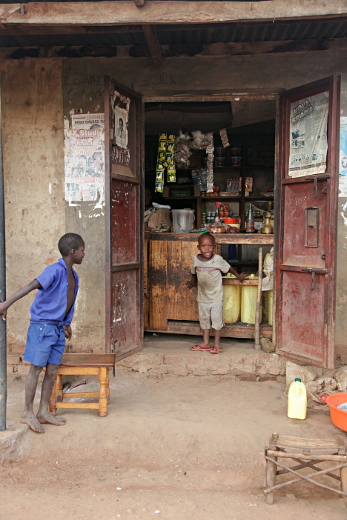 | |
|
Namanyonyi Grocery Store
|
We are met in Namanyoyi by local Jewish villagers. We first visit the synagogue and then go and pay our respects at Samsom's grave. Light is now very low, the sun has set. Though there is a very short twilight here, I still manage to take a few photographs of the commercial and residential areas of Namanyoyi and of course of some of the children. Children may turn out be the main theme of this African visit. I also note that some of the houses have working electric light bulbs.
Namanyoni's commercial area, is comprised of a few sparsely stocked shops and a police station. I am unable to ascertain which of the people I met are "Jewish" and which are not. As I look back on the photographs of the visit, I am unsure who is Jewish and who is not. I suspect that the houses in the vicinity of the synagogue belong to the Jews, but that the people at the shops are not. But I cannot know. I am happy for verification if someone can help.
Back to Mbale
We spend only about ten minutes in Namanyoyi. It's almost dark as we drive off. Fortunately we did not return the way we came, down that very rough hill road from Gangama. It did not take us long to return to the pock-holed main highway. Boniface managed to navigate the maze on the highway without dropping us into the deep.
We arrive back to Mbale and go to the shopping area. We first stop at a supermarket which, while far better stocked than the shops in Namanyoyi, was far from what we are used to. Of course we didn't find anything with a kosher status and didn't buy anything.
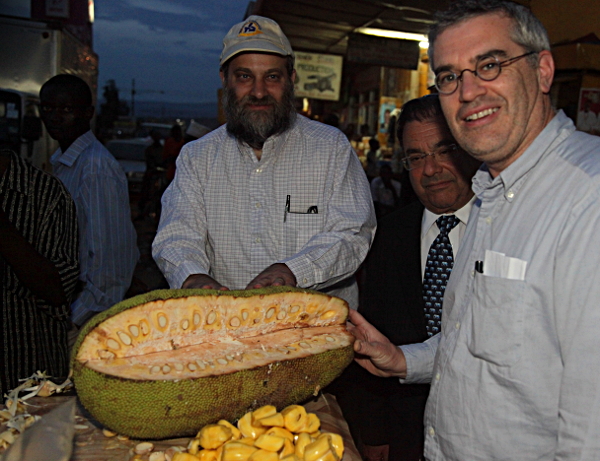 | |
|
Buying a Jackfruit in Mbale
|
There was more available in the way of fruit and vegetables at stalls in the street outside. I bought a kilo of passionfruit for about 80 cents or two shekels. We bought a big Jackfruit for a similar price. I had never seen one of these before, even in South-East Asia where they also grow. It must be one of the biggest fruit there is. It has an interesting, very fruity flavour, reminiscent of a spoonful of tropical fruit salad in one piece.
We head back to the Mount Elgon Hotel. We already knew there would be a problem with my reservation. We sort of hoped it may have resolved itself during the day. My travel companions had made their bookings well in advance. As I only decided to make the trip days before our departure, Enosh could only approach the hotel on my behalf a few days earlier, by email. The hotel's response only arrived the day before our arrival, "We are sorry but the hotel manager has been away for the last four days. In her absence, no-one checked the email. We only received your email today and regret that there are no more available rooms." As I have commented before, Africa marches to a different rhythm.
After dropping everyone else off at the hotel, Boniface and Enosh took me to another hotel in the area. The Crown Suites was not far away, and though not as nice as the Mount Elgon, looked quite clean, was cheaper and had an internet connection -- which worked v-e-r-y slowly. Africa?
I had intended to walk back to see the others, a five minutes stroll, but both Boniface and Enosh both strongly advised me not to go outdoors in the dark. Though it was only 7:30 p.m., it was already a deep black outside. It had a been a long and exciting day which started at 5:30 a.m. in another country. I am both physically and emotionally exhausted and have little trouble falling asleep beneath my mosquito net.
Feel free to view more photographs of Gangama, of Nabugoye and of Namanyoyi.
Menachem Kuchar, 31st July, 2011

|
Please enter your comments on this article to Menachem:
Previous posts:
- Stories HomePage
- All of my earlier stories
- A Travelogue: Visiting the "New" Jews of Africa -- 1. Arrival to Africa
- Traps for Young Wedding Players -- a short guide to perplexed prospectives
- The End of Days -- The Ultimate Fulfilment of Prophecy
- On Leaven, Sourdough, S'or and Hamets
- A Life Saved by Dog Biscuits
- More on Capos -- A moral dilemma
- The Truth Always Comes Out in the End -- Or does it?
- Remembering my Father on Yet Another Anniversary of His Death -- Yartzeit and Kaddish -- An examination of Death
- The Rise of Fair Consumerism in Israel -- From the perspective of both the buyers and of the sellers -- The saga of a rug purchase
- The Tale of the Sage and His Beadle
- A Search for Meaning in the Expanse -- How significant is a link in a chain?
- The History of My Family via My Grandmother's Candlesticks
- A Short History of Computational Machines via my Israeli eyes
- Our Sages Tell Us Our Name is Engraved on Our Very Souls -- Our name is our very essense
- Ultimately It Boils Down to Greed and Stupidity -- Doesn't it always?
- Capos, Kapos and Nazi Murder Revisited -- How do Holocaust victims, and how should we, relate to Capos?
- On Fasting and Feasting on Tisha b'Av-Transition to the End of Days, the Messianic Era or Let the Festivities Begin
- Guilt by Association -- Facebook conversations with Australian political novices and Hungarian rotten egg eaters -- how many degrees of separation?
- Simulating Reality, Prophecy and Physics Revisited -- "You donít ever want a crisis to go to waste; itís an opportunity to do important things that you would otherwise avoid."
- Today is the 17th Day of Tamuz -- Why do we bother fasting?
- What the Price of Privacy -- Why do we insist on spying on ourselves?
- Who Will Ascend the Mountain of the Lord, Who Will Stand Erect in His Holy Place -- He who has clean hands and a pure heart, who has not sworn in vain against My soul and who has not acted with deceit
- More on Simulating Reality -- Responses and discussion on the original post
- Facebook and Styrofoam -- Man is a Social Creature
- Simulating Reality -- "I, at any rate, am convinced that He does not throw dice"
- Why Do Jews Love a Free Lunch? Anything, Anywhere and with Anyone
- The Present and Future of Communications and Social Media
- The Putrid Parable of the Capped CupCakes A picky porcine person's particularly prickly problematic predicament
- The New World Order via the Prophets of Israel
- The Place of the Holy Temple Today
- The Road from Presov to Kosice. A Mere Sixty Kilometres or an Eternity?
- It's a Matter of How You Say It
- On Matza, Soccer Balls and Red Wine -- How long is a piece of string?
- Woosh, Plump, Ploop, Shhhhh
- On the Psychology of Sex and Wombats
- Stay Away from Bureaucracy. It will swallow you alive
- A Eulogy to my late mother
- The Power of the Web. Finding a manuscript and a family
- Why I Like to Photograph Reflections or Why Do I Always Do Things in Reverse?
- A DisKosher Disdelight. Almost eating out on Broadway
- What Was the Crime of the Sodomites? -- Jingoism, xenophobia or sodomy?
- The more things change, the more they stay the same -- On Babel, the New World Order, One World Government, Carbon Trading and Socialism
- Three Holocaust Experiences: My friends tell me their stories
- "The End is Nigh" -- The clock ticks on -- another step towards Final Redemption
- The History of My Family via My Grandmother's Candlesticks
- I Once Had an Uncle
- Another Uncle and Another, Very Different, Holocaust Experience
- Demographics -- It's Absolutely Not Only About Numbers
- Three Men Spend a Night in a Cold Birmingham Hotel Room
- Swimming with Orders of Nuns and Phyla of Crustaceans
- A Hassidic Story in Real Time
- The Lesbian Rabbi Lied to Me
- All of my Stories
And don't forget to look at my latest (and classic) photographs at www.Menachem.co.il
Enjoy!
